Pergolas: An Introduction
Do you want to create a beautiful space in your backyard to host guests? Would you like to add diversity and texture to your lawn or garden?
Look no further than the pergola!
A simple yet elegant backyard structure, the pergola is an affordable option that doesn’t require any aesthetic sacrifices. It provides a bit of shade and wind protection while allowing you to fully experience the outdoors.
Here at Fisher’s Backyard Structures, we care about providing beautiful, high-quality, cost-effective backyard structures. We love pergolas and think you might, too.
In this article, we’ll introduce you to the pergola, its features, uses, and how it compares to other backyard structures.
Want to learn more?
Let’s begin!
What Is a Pergola?
You may be asking, what on earth is a pergola?
If so, you’re not alone.
Outside of landscaping businesses, many people aren’t really sure what a pergola is. To make matters worse, pergolas are often mislabeled as gazebos, arbors, and trellises to name a few.
Since this is so common, let’s start with the basics.
A pergola is an outdoor structure often found in gardens, backyards, porches, or decks.
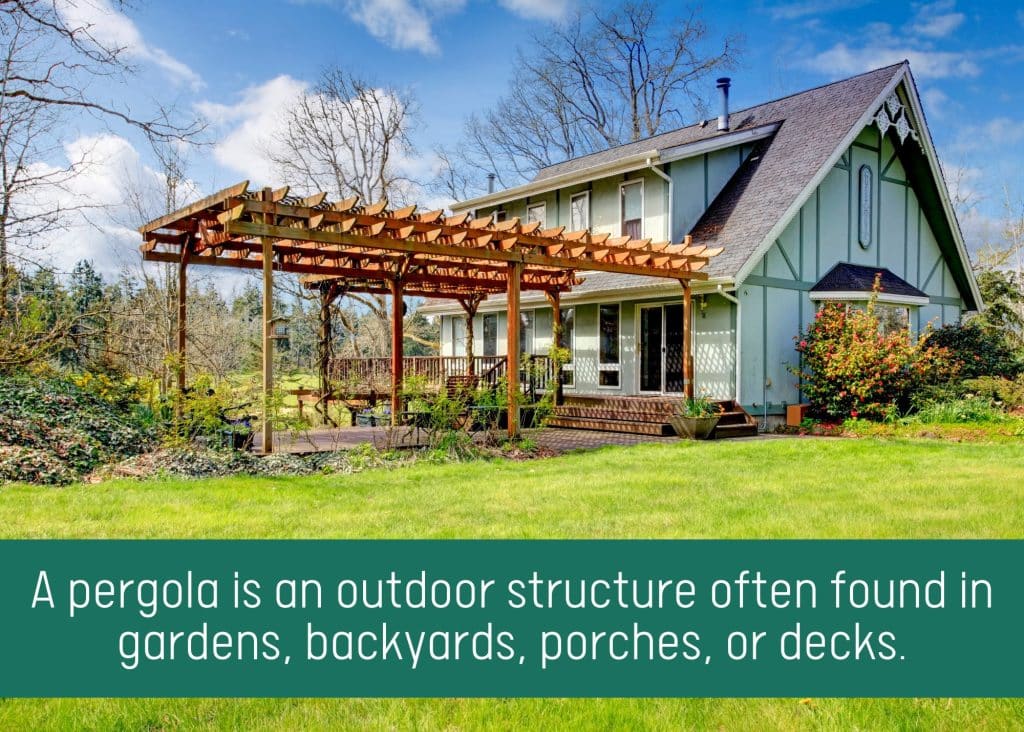
A pergola has a roof of open crossbeams (also called purlins) supported by four or more pillars or posts. It’s a common practice to train vines or flowers to grow over the pergola for added shade, wind protection, and beauty.
Pergolas can be free-standing or attached to a building. They range significantly in size, from small, four-cornered structures that offer space for only a few people to long structures that cover paths or walkways.
Does this type of structure sound a bit odd?
Don't worry! Pergolas are tried and true.
Pergolas are a tried and true backyard and garden structure! There is some evidence that pergola-like structures date to as early as 1400 BC and were a feature of some ancient Egyptian gardens.
However, the word “pergola” didn’t originate till 17th-century Italy. Ancient and medieval pergolas were also built with different materials from what is popular now. When they gained popularity in England during the mid-1600s, pergolas were commonly built with colonnades of brick or stone which supported study cross beams. All that to say, when you incorporate a pergola into your backyard, you can be confident you are utilizing a style that has been considered beautiful for centuries!
Pergola Materials
Modern pergolas are built from a wide range of materials. Some of the most popular materials are wood and vinyl, with other options including metal, fiberglass, and PVC.
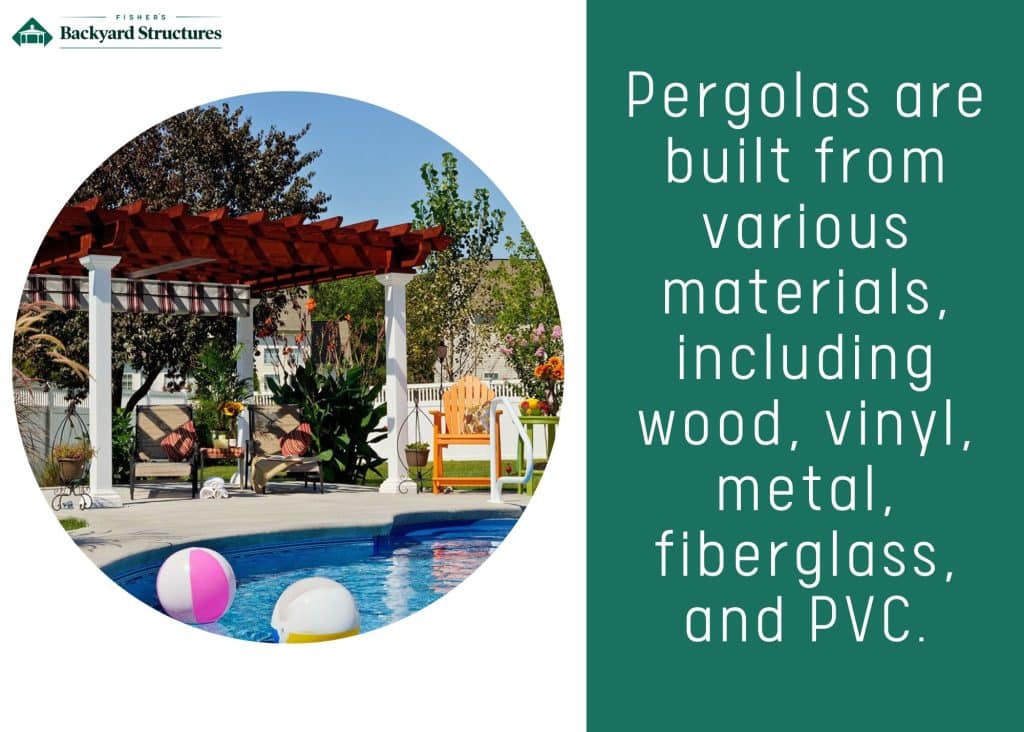
Let’s take a closer look at each.
Wood
Wood is an excellent material for a pergola, especially if you’re wanting a classic, natural look. The wood used to build a pergola needs to be strong and able to withstand moisture. Kinds of wood that do this well include ipe, redwood, cedar, and pine. In most cases, the wood is pressure-treated to prevent moisture damage and increase its lifespan. The one major drawback to wood is that wood pergolas do need regular maintenance like annual cleaning and restaining or repainting every few years.
Vinyl
Another popular material used to build pergolas is vinyl. Because vinyl itself is very light, the frame of a vinyl pergola is made from sturdy pressure-treated wood. The vinyl is then wrapped around the frame creating a clean, modern look. Vinyl pergolas are strong, low-maintenance structures and are able to withstand winds of up to 140 mph (when installed correctly by a professional). One con to vinyl pergolas is that they are often a bit more costly than wood pergolas.
Metal
Metal pergolas are less popular, but are very durable, relatively low maintenance, and a great option for anyone who wants a more a-typical or industrial look. Aluminum is a lighter metal option and can be wrapped in vinyl for a more conventional look. Steel is much heavier, so some consideration needs to go into the placement of a steel pergola (for example, if you want one on a raised deck, the deck will probably need to be reinforced). Along with being a less popular aesthetic, metal pergolas tend to be quite expensive.
Fiberglass
Fiberglass pergolas are a long-lasting, low-maintenance, highly-customizable option. Fiberglass does well in many weather conditions and is often hard to differentiate from vinyl. Despite all these pros, fiberglass remains less popular due to its considerable price tag.
Stone
In 17th century England, stone was a common material used in pergola construction. Although not as common today, stone still makes a great material for pergola pillars.
Concrete
Concrete is another material that is sometimes used for pergola pillars. Generally used for large pergolas, concrete is very uncommon for private pergolas.
If you're not sure which material to choose, it may be helpful to read our blog on wood vs vinyl outdoor structures!
Pergola Styles
Much of a pergola's style comes from its materials, but not all! There are many different pergola designs to choose from.
Let’s take a closer look at the six styles we offer here at Fisher’s Backyard.
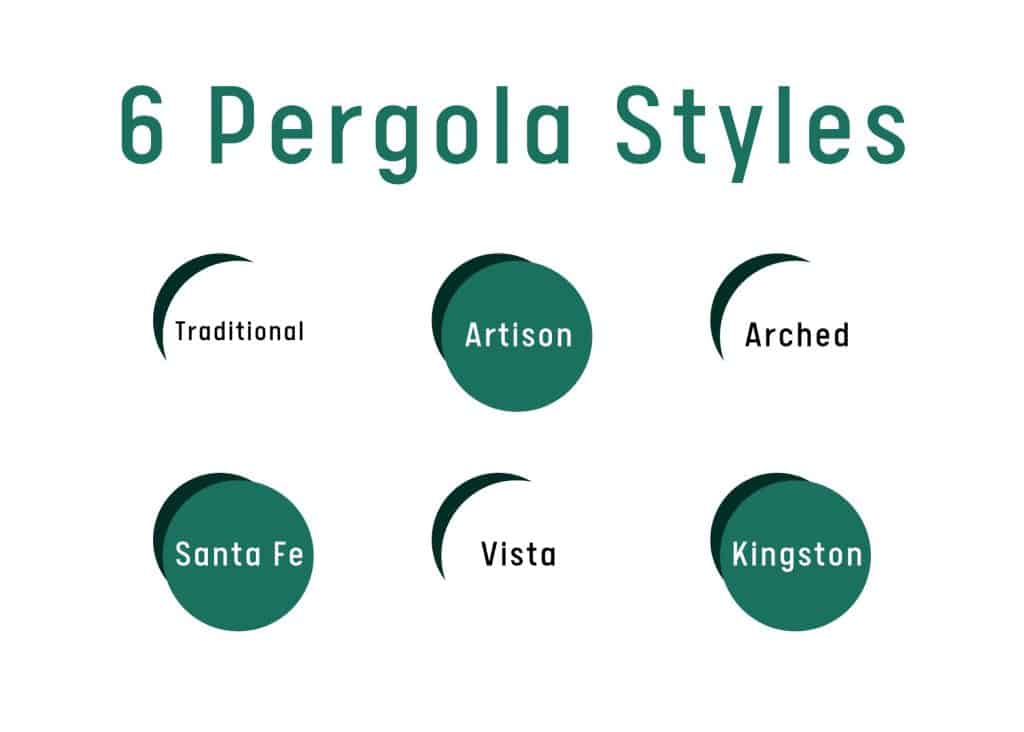
1. Traditional
As it sounds, this is the classic pergola design. Available in both vinyl and wood, this design features scalloped purlin ends to provide a simple, elegant look.
2. Artison
Designed to be a statement piece, the Artison pergola features pillars with decorative trim instead of simple posts. The roof includes notched roof intersections (when using wood) and detective end caps (when using vinyl).
3. Arched
The arched pergola brings a romantic, Mediterranean feel right to your backyard! Features half-moon braces and arched, scalloped joists; this elegant design can be built with either wood or vinyl.
4. Santa Fe
This contemporary design includes large curved braces and an angled roof for an overall sturdy, comfortable aesthetic.
5. Vista
For those wanting a modern pergola that still captures the essence of the traditional style, the Vista is a great option. Unlike other styles in which the rafters overhang the support pillars, the Vista features a large, powder-coated bracket at the top of the post. This creates a sturdy, simple design that offers unobstructed views.
6. Kingston
Available exclusively in cedar, this design utilizes rough-sawn lumber for a perfectly rugged, rustic appearance.
Uses and Benefits of a Pergola
Now that we’ve discussed the various pergola styles let’s take a look at the various advantages that come along with owning a pergola.
As we alluded to in the introduction, there are many uses and benefits of a pergola.
Let’s start with the uses of a pergola.
Uses
- Create an outdoor hospitality/relaxation space
Pergolas make great outdoor hospitality spaces. If you are more of an introvert, pergolas are also excellent spaces for relaxing comfortably outdoors by yourself or with your family.
We've even written some tips on how to use your structure all year long!
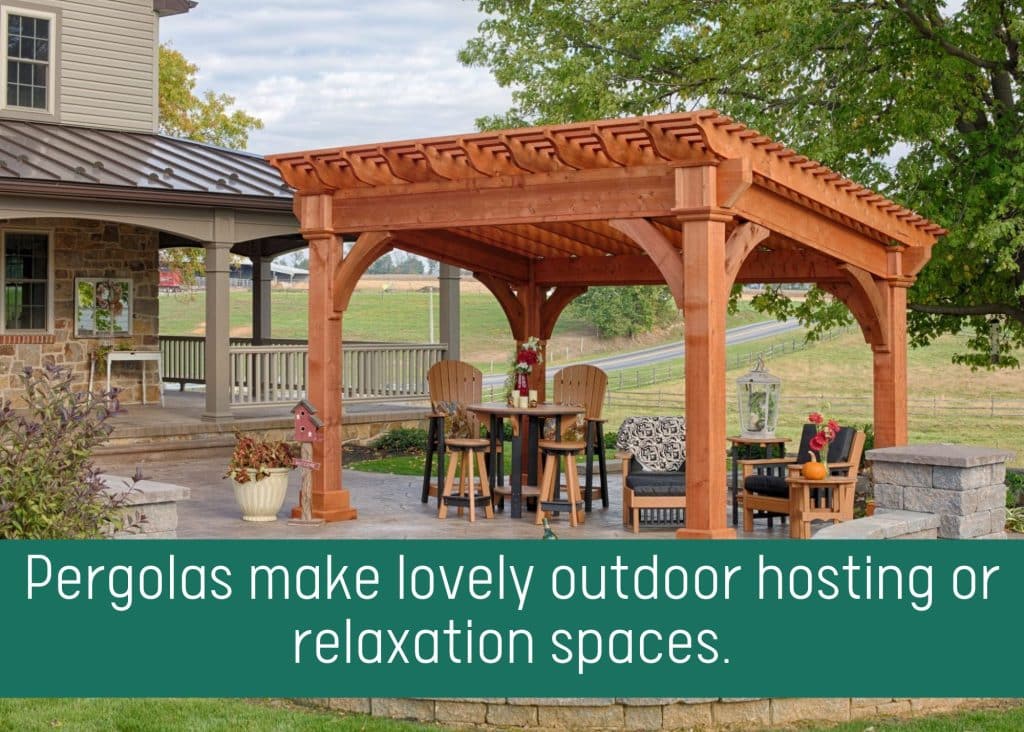
- Carport
Pergolas can be designed as carports, offering your car a bit of protection from the weather while keeping your home looking warm and aesthetically pleasing.
- Elevate a patio, pool, or hot tub
A simple way to uplift any outdoor amenity is to have a pergola! Not only does it add a bit of privacy (especially if you add a screen - more on that later), but it also adds textures and visual interest to your outdoor area.
- Cover a walkway
Want to create a romantic walkway? Cover it with a pergola! Add flowering or green vines for additional beauty.
- Add texture to a garden or backyard
A pergola is an elegant, low-maintenance way to add visual interest to any garden or backyard.
Now that we’ve looked at a few of the uses for pergolas let’s transition to the benefits that come with owning a pergola.
Benefits
- Shade and Sun
Imagine for a minute that it's a sunny spring day. You want to enjoy the lovely weather but don’t want to be in direct sunlight or risk getting burned. After all, too much sun leads to skin cancer! On the other hand, you still need Vitamin D from the sun to be healthy. A pergola allows you to soak up some sun without getting all the negative effects.
Pergolas offer some shade without blocking out all of the sun’s rays.
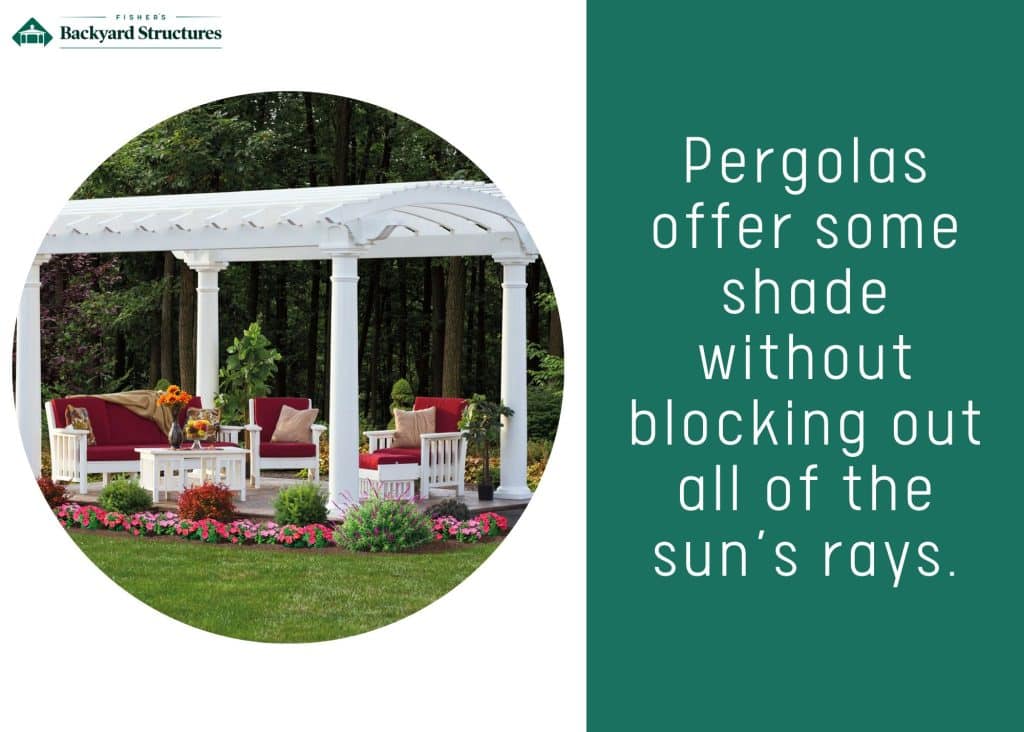
This creates a lovely combination of sunshine and shade. The precise level of shade, of course, varies based on the pergola design, whether there are greens growing over it, and if there is a shade canopy (more on this later).
- Beauty
Pergolas add beauty and visual interest to an outdoor space. They provide spaces for hanging pots and climbing plants such as climbing roses, wisteria, honeysuckle, grape vines, and more. Pergolas also break up an outdoor space, creating pleasing nooks for entertaining and relaxing.
- Adds Value
In addition to adding beauty to your home, a pergola adds value to your home. The home website Angi estimates that building a pergola in your backyard adds about 55% of the cost directly to the value of your home.
- Affordable
Pergolas are an affordable option when compared to their closest cousins in backyard structures, gazebos, and pavilions. While pergolas do function a bit differently from gazebos and pavilions, they are similar enough to provide an excellent alternative without any aesthetic sacrifices.
Common Pergola Sizes
Pergolas are generally very customizable and so can be built to meet the needs of the homeowner. That being said, there are some more common pergola sizes.
For example, popular rectangular sizes include 12x16 pergolas which are comfortable and cozy, while 16x20 pergolas offer a bit more space. Popular sizing for square pergolas includes 16x16 and 20x20.
Pergola Add-Ons
As we alluded to several times already, there are a number of features you can add to your pergola. Here are five common, helpful add-ons.
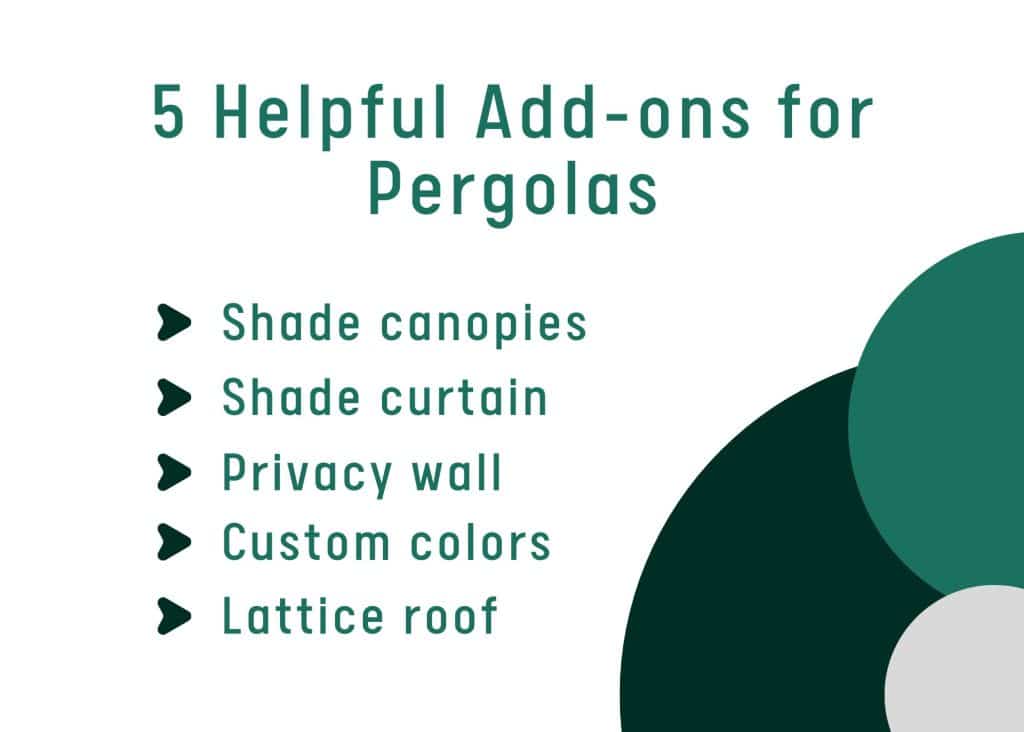
- Shade Canopies
While pergolas provide some shade, they may not always provide enough on a hot, sunny summer day. Enter shade canopies! This useful add-on attaches to the underside of the pergola's roof and provides additional shade. It even offers some rain protection. Shade canopies can be automated or manual and are available in different thicknesses.
- Shade Curtain
Like shade canopies, shade curtains provide additional shade. Rather than being attached under the roof, they can be attached to any (or all) of the sides of the pergola. In addition to protection from the sun, shade curtains create the option of greater privacy.
- Privacy Wall
Want to add privacy to your pergola? A privacy wall could be just the thing. While shade curtains give the option of privacy, a privacy wall makes it permanent. Generally made from lattice or wooden slats, privacy walls are especially useful when there is easy visibility into your backyard from a public space or a neighbor's lawn.
- Custom Colors
There are almost endless stains and paints you can choose to add color to your pergola! This makes it easy to find the one that matches your home/garden color pallet. (Note: vinyl cannot be painted, so once you make a color decision, it cannot be easily changed.)
- Lattice roof
A simple way to add additional shade is a lattice roof. This is also an excellent choice if you want to grow vines or flowers over your pergola.
Placing Your Pergola
While placing your pergola is mostly a matter of personal preference, there are a few factors to consider.
1. Shade
How much shade do you prefer? When will you most use your pergola? These are important questions when considering where and how to place your pergola. For example, if the rafters are situated from north to south, they will provide considerably more shade than those if they are situated east to west. Placing the pergola near your home will also provide increased shade.
2. Optimal views
What views do you want to highlight? Do you have a great view of a lake, valley, or skyline? Whether it's a great spot to watch the sunset or gives the best view of your favorite side of the garden, consider placing your pergola where these views are set to the best advantage.

3. Ease of access
How do you want to use your pergola? If you want to use it to host friends and family, consider placing it near your other outdoor amenities like your grill or outdoor kitchen. If you want to use it as a quiet getaway, consider placing your pergola farther away from your home.
4. Special places
Are there places you want to highlight that are special to you? For example, a walkway you built or your raised-bed garden. A pergola is a wonderful way to draw attention and add beauty to these meaningful spaces
Conclusion
Pergolas are beautiful, affordable backyard structures. They provide spaces to enjoy the outdoors, host friends, or simply relax while also adding value to your home.
Purchasing a pergola from Fisher’s Backyard Structures is as easy as 1-2-3-4!
- Use our online tool to design your pergola.
- We’ll send you a quote based on your design.
- After receiving the downpayment, we’ll schedule and install your pergola.
- Enjoy your beautiful new pergola!
In addition to pergolas, Fisher’s Backyard Structures offers custom pavilions and gazebos. If you found this article helpful, you may also enjoy our Ultimate Guide to Gazebos and our article on timber frame pavilions.
If you have any additional questions about pergolas (or any of our other services), give us a call!
We hope to hear from you soon!








